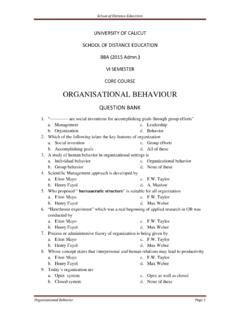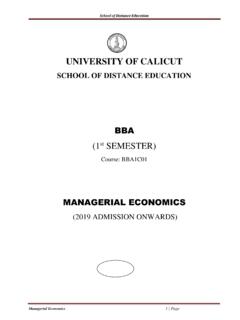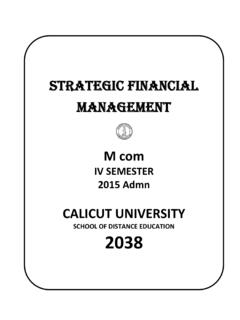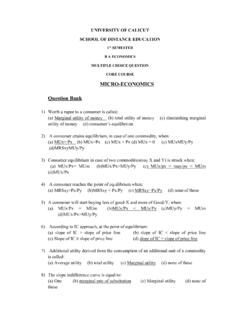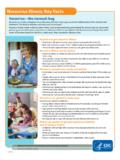Transcription of ELECTRICAL DRIVES & CONTROL
1 EE A Course Material on ELECTRICAL DRIVES & CONTROL SEMESTER IIELECTRICAL DRIVES AND CONTROLL1 PRINTING TECHNOLOGY-SDE MODE SEMESTER IIELECTRICAL DRIVES AND CONTROLL2 PRINTING TECHNOLOGY-SDE MODE 3 , ,AP/EEE 2015-16 EE6361 ELECTRICAL DRIVES AND CONTROL Unit-I Introduction Basic elements-types of electric DRIVES -factors influencing electric DRIVES -heating and cooling curves- loading conditions and classes of duty-Selection of power rating for drive motors with regard to thermal overloading and load variation factors Unit- II Drive motor characteristics Mechanical characteristics- speed- torque characteristics of various types of load and drive motors -braking of ELECTRICAL motors-dc motors.
2 Shunt, series, compound motors-single phase and three phase induction motors Unit- III Starting methods Types of motor starters-typical CONTROL circuits for shunt and series motors-three phase squirrel and slip ring induction motors Unit-IV Conventional and solid state speed CONTROL of DRIVES Speed CONTROL of DC series and shunt motors-Armature and field CONTROL , ward-leonard CONTROL system-using controlled rectifiers and DC choppers applications Unit-V Conventional and solid state speed CONTROL of AC DRIVES Speed CONTROL of three phase induction motor-Voltage CONTROL , voltage/frequency CONTROL , slip power recovery scheme-using inverters and AC voltage regulators-applications TEXT BOOKS 1. VEDAM SUBRAMANIAM Electric DRIVES (concepts and applications) , Tata 2.
3 & KOTHARI . , ELECTRICAL machines , Tata REFERENCES 1. A first course on Electric DRIVES , Wiley Eastern Limited, 1998 2. SINGH, , Power electronics, Tata 3. , Art and science and utilization of ELECTRICAL energy, Dhanpat Rai and sons, 1994 SEMESTER IIELECTRICAL DRIVES AND CONTROLL3 PRINTING TECHNOLOGY-SDE MODE 4 , ,AP/EEE 2015-16 CHAPTER CONTENT PAGE NO 1 INTRODUCTION TO ELECTRICAL DRIVES INTRODUCTION 7 BLOCK DIAGRAM OF AN ELECTRICAL DRIVES 7 BASIC COMPONENT (or) ELEMENTS OF ELETCRIC DRIVES 8 FACTORS INFLUENCING THE CHOICE OF ELECTRICAL DRIVES 9 CLASSIFICATION OF ELECTRIC DRIVES WITH FACTOR 10 Group drive 10 Individual drive 10 Multimotor drive 11 LOAD CONDITIONS IN MOTOR 11 Classification of loads 11 Different type of industrial loads 11 HEATING AND COOLING CURVES 12 CLASSES OF MOTOR DUTY 15 SELECTION OF POWER RATING OF MOTORS 18 Continuous duty and constant load 18 Continuous duty and variable load 18 Short time rating of motor 22 2 DRIVE MOTOR CHARACTERISTICS TYPES OF ELECTRICAL MACHINES 25 Applications of Dc Motor 25 Characteristics of Dc Motors 25 Types of Electric Braking 26 DC
4 SHUNT MOTORS 26 Characteristics of Dc Shunt Motor 26 Electric Braking in Dc Shunt Motor 28 DC SERIES MOTOR 31 Characteristics of Dc Series Motor 31 Electric Braking in Dc Series Motor 33 COMPOUND DC MOTOR 34 Characteristics of DC Compound Motor 34 Electric Braking in DC Compound Motor 35 APPLICATIONS OF DC MOTORS 36 SINGLE PHASE INDUCTION MOTORS 36 CONSTRUCTION AND WORKING PRINCIPLE 36 TORQUE-SLIP CURVE FOR INDUCTION MOTOR 38 ELECTRIC BRAKING IN AC INDUCTION MOTOR 38 THREE PHASE INDUCTION MOTOR 41 CONSTRUCTIONAL DETAILS 42 SEMESTER IIELECTRICAL DRIVES AND CONTROLL4 PRINTING TECHNOLOGY-SDE MODE WORKING PRINCIPLE OF THREE PHASE INDUCTION MOTOR 45 3 STARTING METHODS 47 INTRODUCTION 47 Prime Purpose (or) Necessity of a Starter For Motors 47 Protective Devices in a DC/AC Motor Starter 47 Starters for DC Motor 47 THREE POINT STARTER 48 FOUR POINT STARTER 49 TWO POINT STARTER 50 STARTERS FOR AC STARTERS 52 Necessity for Starter 52 Prime Purpose of a Starter For Motors 53 Need For Starter in an Induction Motor 53 STARTER 53 STATOR RESISTANCE (OR) PRIMARY RESISTANCE STARTER 54 PRIMARY REACTANCE STARTER (or)
5 AUTO TRANSFORMER STARTERS 55 STAR DELTA STARTER 58 ROTOR RESISTANCE STARTERS 59 COMPARE THE INDUCTION MOTOR STARTERS 60 4 CONVENTIONAL & SOLID STATE SPEED CONTROL OF DRIVES INTRODUCTION 62 EXPRESSION FOR SPEED FOR A DC MOTOR 62 Applications of DC DRIVES 62 Advantages of DC DRIVES 62 Conventional Methods of Speed CONTROL 63 Speed CONTROL of DC Shunt Motors 63 Speed CONTROL of DC Series Motors 64 Ward Leonard CONTROL System 65 Solid state Speed CONTROL of DC Motor 66 Single phase Controlled rectifier fed DC DRIVES 67 5 CONVENTIONAL & SOLID STATE SPEED CONTROL AC DRIVES INTRODUCTION 72 SPEED CONTROL OF DRIVES 72 Advantages of Induction motor 72 Applications of Induction motors 72 Speed CONTROL of three phase induction motor 73 Slip Power Recovery Scheme 75 SEMESTER IIELECTRICAL DRIVES AND CONTROLL5 PRINTING TECHNOLOGY-SDE MODE UNIT-I INTRODUCTION Basic elements Types of electric DRIVES Factors influencing electric DRIVES Heating and cooling curves Loading conditions and classes of duty Selection of power rating for drive motors with regard to thermal overloading and load variation factors SEMESTER IIELECTRICAL DRIVES AND CONTROLL6 PRINTING TECHNOLOGY-SDE MODE INTRODUCTION 1.
6 INTRODUCTION Drive: A combination of prime mover, transmission equipment and mechanical Working load is called a drive Electric drive: An Electric Drive can be defined as an electromechanical device for converting ELECTRICAL energy to mechanical energy to impart motion to different machines and mechanisms for various kinds of process CONTROL . BLOCK DIAGRAM OF AN ELECTRICAL DRIVES The basic block diagram for ELECTRICAL DRIVES used for the motion CONTROL is shown in the following Fig Block Diagram for ELECTRICAL DRIVES The aggregate of the electric motor, the energy transmitting shaft and the CONTROL equipment by which the motor characteristics are adjusted and their operating conditions with respect to mechanical load varied to suit practical requirements is called as electric drive.
7 Drive system=Drive + load UNIT 1 SOURCE AC (or) DC POWER MODULATOR SENSING UNIT LOAD MOTOR CONTROL UNIT INPUT SEMESTER IIELECTRICAL DRIVES AND CONTROLL7 PRINTING TECHNOLOGY-SDE BASIC COMPONENT (or) ELEMENTS OF ELETCRIC DRIVES Block diagram of electric drive: 1. Load: usually a machinery to accomplish a given task. Eg-fans, pumps, washing machine etc. 2. Power modulator: modulators (adjust or converter) power flow from the source to the motion 3. Motor: actual energy converting machine ( ELECTRICAL to mechanical) 4. Source: energy requirement for the operation the system. 5. CONTROL : adjust motor and load characteristics for the optimal mode. Power modulators: Power modulators regulate the power flow from source to the motor to enable the motor to develop the torque speed characteristics required by the load.
8 The common function of the power modulator is, They contain and CONTROL the source and motor currents with in permissible limits during the transient operations such as starting, braking, speed reversal etc. They converts the input ELECTRICAL energy into the form as required by the motors. Adjusts the mode of operation of the motor that is motoring, braking are regenerative. Power modulators may be classified as, Converters uses power devices to convert uncontrolled valued to controllable output. Switching circuits switch mode of operation Variable impedance Converters They provide adjustable voltage/current/frequency to CONTROL speed, torque output power of the motor. The various type of converters are, AC to DC rectifiers DC to DC choppers AC to AC choppers AC to AC AC voltage controllers (voltage level is controlled) Cyclo converter (Frequency is controlled) DC to AC inverters Switching circuits Switching circuits are needed to achieve any one of the following.
9 Changing motor connection to change its quadrant of operation. Changing motor circuits parameters in discrete steps for automatic starting and braking CONTROL . For operating motors and DRIVES according to a predetermine sequence To provide inter locking their by preventing maloperation SEMESTER IIELECTRICAL DRIVES AND CONTROLL8 PRINTING TECHNOLOGY-SDE MODE Disconnect under up normal condition Eg: electromagnetic contacters, PLC in sequencing and inter locking operation, solid state relays etc. Variable impedance Variable resisters are commonly used for AC and DC DRIVES and also needed for dynamic braking of DRIVES Semiconductors switch in parallel with a fixed resistance is used where stepless variation is needed.
10 Inductors employed to limit starting current of ac motors. FACTORS INFLUENCING THE CHOICE OF ELECTRICAL DRIVES (i) Nature of electric supply Whether AC or DC supply is to be used for supply (ii) Nature of the drive Whether the particular motor is going to drive individual machine or a group of machines (iii)Capital and running cost (iv) Maintenance requirement (v) Space ad weight restrictions (vi) Environment and location (vii) Nature of load Whether the load requires light or heavy starting torque Whether load torque increases with speed remain constant Whether the load has heavy inertia which may require longer straight time (viii) ELECTRICAL characteristics of motor Starting characteristics, running characteristics, speed CONTROL and Braking characteristics (ix)

